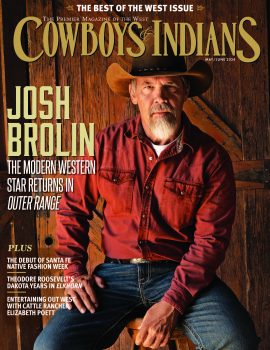We caught up with the genre-jumping writer-director of In a Valley of Violence, a forthcoming western starring Ethan Hawke.
After making his mark with a string of scary movies — including such well-received features as The House of the Devil, The Innkeepers, and The Sacrament — filmmaker Ti West wanted to work in a genre that, considering his name, might seem his natural habitat. Fortuitously, he connected with actor Ethan Hawke (above) and producer Jason Blum just when they, too, were hankering to earn their spurs with a little Wild West action. The result of their collaboration: In a Valley of Violence, a brutally gritty and slow-burningly suspenseful drama that is laced with elements of dark comedy, abounding in deadly serious mayhem, and loaded with tips of the Stetson to classic spaghetti westerns.
The official plot synopsis: A mysterious drifter named Paul (Hawke) and his dog Abbie make their way toward Mexico through the barren desert of the Old West. In an attempt to shorten their journey they cut through the center of a large valley, landing themselves in the forgotten town of Denton — a place now dubbed by locals as a “valley of violence.” The once-popular mining town is nearly abandoned, and controlled by a brash group of misfits and nitwits. Chief among them: the seemingly untouchable Gilly (James Ransone), who is the troublemaking son of the town’s unforgiving marshal (John Travolta).
As tensions rise between Paul and Gilly, Denton’s remaining residents bear witness to an inevitable act of violence that starts a disastrous chain reaction, infecting the petty lives of all involved, and quickly drags the whole town into the bloody crosshairs of revenge. Mary-Anne (Taissa Farmiga) and Ellen (Karen Gillan), two bickering sisters who run the town’s only hotel, try to find the good in both men, while desperately searching for their own salvation. Only the world-weary marshal struggles to stop the violent hysteria. But after a gruesome discovery about Paul’s past, there is no stopping the escalation.
We caught up with writer-director West, a 35-year-old native of Wilmington, Delaware, on the afternoon after In a Valley of Violence impressed audiences during its world premiere at the SXSW Film Festival in Austin. In the course of our freewheeling chat, he enthusiastically fielded questions about upending genre conventions, employing lessons he learned from Clint Eastwood classics, and sustaining a rooting interest in a good guy who does very bad things. Here are highlights from our conversation.
Cowboys & Indians: What movies served as your gateway to the western genre while you were growing up?
Ti West: The first westerns I was introduced to was probably the “Dollars Trilogy” — A Fistful of Dollars, For a Few Dollars More, and The Good, The Bad, and the Ugly — but I didn’t know them specifically as spaghetti westerns. I just thought, like, “Yeah, there’s the guy that’s in westerns, Clint Eastwood.” I think that I had probably seen Stagecoach and other John Ford movies. But I didn’t appreciate those until maybe when I was in my teenage years, and became interested in film as cinema. Then they became interesting to me.
C&I: It’s been said that, deep down, every director wants to make a least one Alfred Hitchcock-like thriller and one western.
West: I agree. And it’s funny: I’m not that interested in realism or plot in movies. There are times that, like in an Agatha Christie movie, plot is super important. And there are times when you see a movie where you do really want some sort of authenticity, a sense of feeling real. But I go to movies knowing that they’re an artistic thing. They’re a reflection of reality — they’re not actually reality. To me, movies that heighten reality, or comment on that — those are the most interesting movies.
And when you think about it, all the spaghetti westerns — they’re not realistic at all. They’re practically absurdist. I don’t think people casually watch them and think about how weird they are, because that just seems baked into it. But Hitchcock movies are the same way. The music is bombastic. The way the camera moves is like the director is telling you, “All right, I’m going to show you something that you need to know.” It’s like the art of cinema versus just being a movie.
C&I: Actually, the realistic elements you introduce in your movies either undercut or enhance genre conventions. In The Innkeepers, for example, the haunted hotel isn’t some spooky Gothic castle — it’s a fairly nondescript downtown hotel that doesn’t look like it’s been renovated since the 1970s. And In a Valley of Violence may be set in the Wild West we think we’re familiar with — but not everybody there is very well equipped to deal with violence. Even most of the antagonists aren’t very good with guns.
West: To me, it’s so much fun to play with archetypes in that way. That was the thing here, to set up all these western archetypes and elements you’re familiar with — and then, when the characters have to face the things they’re faced with in this movie, you see they’re in way over their heads. Hopefully, when you start to see how they react to the violence that erupts, you’ll see that everyone reacts differently, and it affects them in different ways. Some of the violence in the movie is really horrific. Some of it’s really funny. But when I hear people laugh at the movie — well, there are no jokes in the movie. They’re laughing at the absurdity of the situation that these people are in.
C&I: Of course, you use the classic western convention of having men who have already witnessed more than their fair share of violence — the drifter played by Ethan Hawke, and the marshal played by John Travolta — trying their best to cool down the hotheads, even after the shooting starts.
West: Yeah. They’ve been through it, and they don’t want anything to do with it anymore. In a way, Ethan’s like, “Look, I don’t even want to be a part of this,” and Travolta’s like, “I see what’s going on here. How about you just leave so we can avoid all that?” They’re the only sensible ones, because they've seen how bad it gets. The people who haven’t seen how bad it gets fetishize it and love the idea of violence. People who’ve actually seen it realize this is not something you want to be a part of.
C&I: On the other hand, you have someone like the character played by James Ransone — Gilly, Marshal’s loutish son — who wants to prove what a real man he is by picking a fight with someone, anyone. He makes a big mistake when he tangles with Paul. And then he makes a bigger mistake by seeking revenge after Paul knocks him down with one punch.
West: To me, an actual tough person is not scary. An actual tough person has no interest in proving how tough he is. The scary people are stupid people like Gilly, who need to prove something. He’s scary because when he loses, he can’t let it go because he’s insecure. Then he takes it too far, and this snowball starts rolling. Those are the people that you have to be afraid of, people who don’t think. People who just act on ego and then all a sudden, they've created this situation that you can't get out of.
See, the title has a double meaning. They technically call this place Valley of Violence because they’re in a valley. But also, all these characters get stuck in this violent scenario and they can’t get out of it. Because once everyone’s affected by it, no one can just let it go.
C&I: And that’s where you really flip the convention around. Because even though we’re sympathetic to Paul at first, because of what these bad guys do to his dog, there comes a point when ...
West: My hope is that you’re with Ethan the whole movie. He’s our protagonist. But, yeah, in the second half of the movie, he’s also sort of the bad guy. In my mind, even if the other guys are bad guys and you want them to die — they’re still sad when their friends die, too. You know what I mean?
These guys have to die, of course, because they’ve attacked [Paul], who did nothing to them. But when Paul comes back and so violently attacks them, you see them as human beings, even if they've done something wrong.
C&I: And Paul becomes, well, pretty dang scary himself.
West: The first killing is pretty ugly. And it’s almost like a slasher movie after that. Paul’s just stalking them, and waiting for them to make mistakes.
C&I: But it’s like you say — Paul never really stops being the protagonist. Ethan Hawke manages to retain the audience’s sympathy, even while his character is behaving monstrously.
West: We were always sort of partners in crime on this movie. And you know what? He’s perfect for westerns. As an actor, and as a film fan, and even just as a man. And I remember after this movie, when he started having talks about doing other westerns — I saw his eyes light up about it.
C&I: Sounds like you both enjoyed getting your cowboy on.
West: [Laughs.] Yeah, when you’re out there in the middle of nowhere, filming guys with horses and hats shooting at each other — there’s nothing cooler. It feels so satisfying.
In a Valley of Violence hits theaters in select cities and on VOD and Digital HD October 21, 2016.












